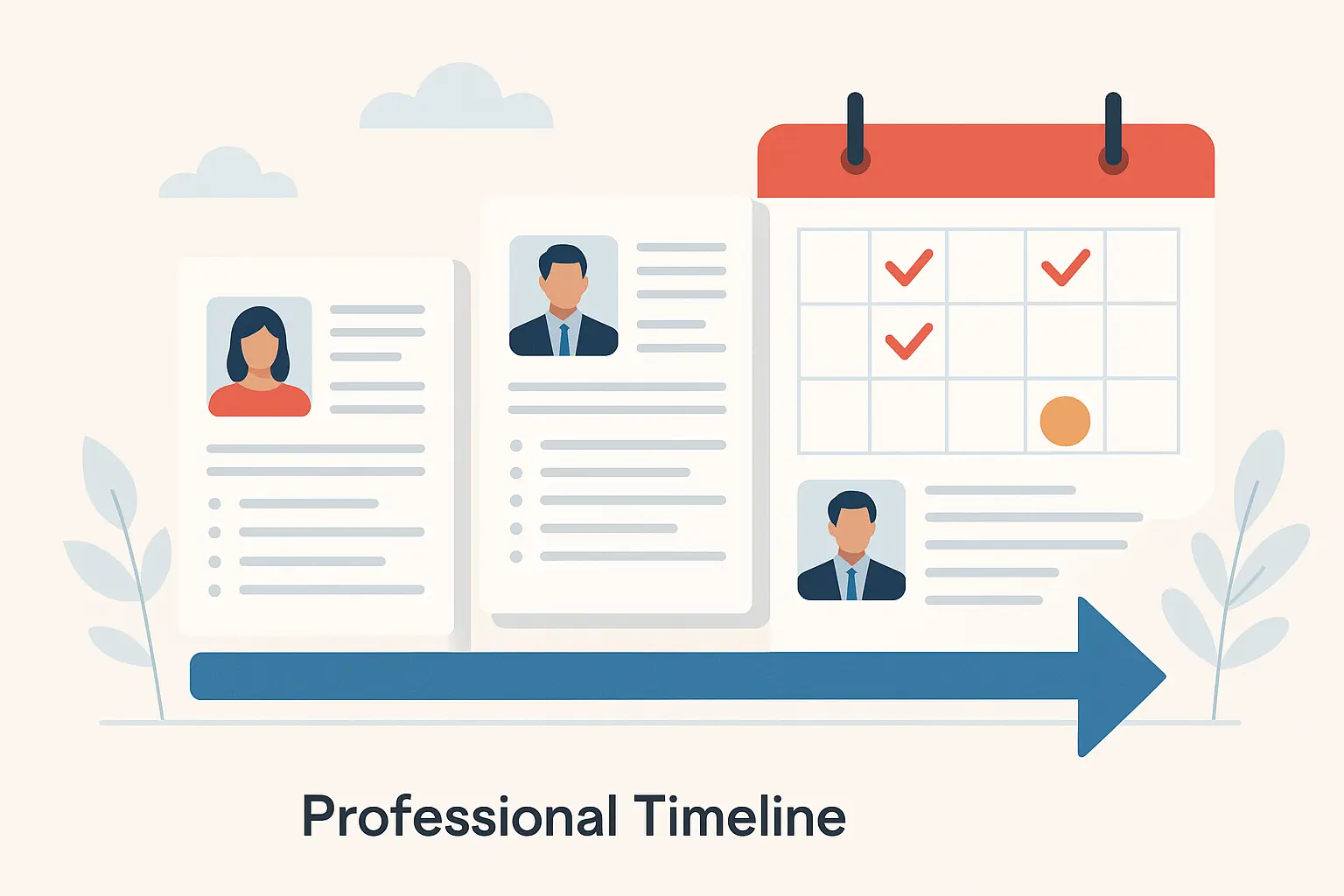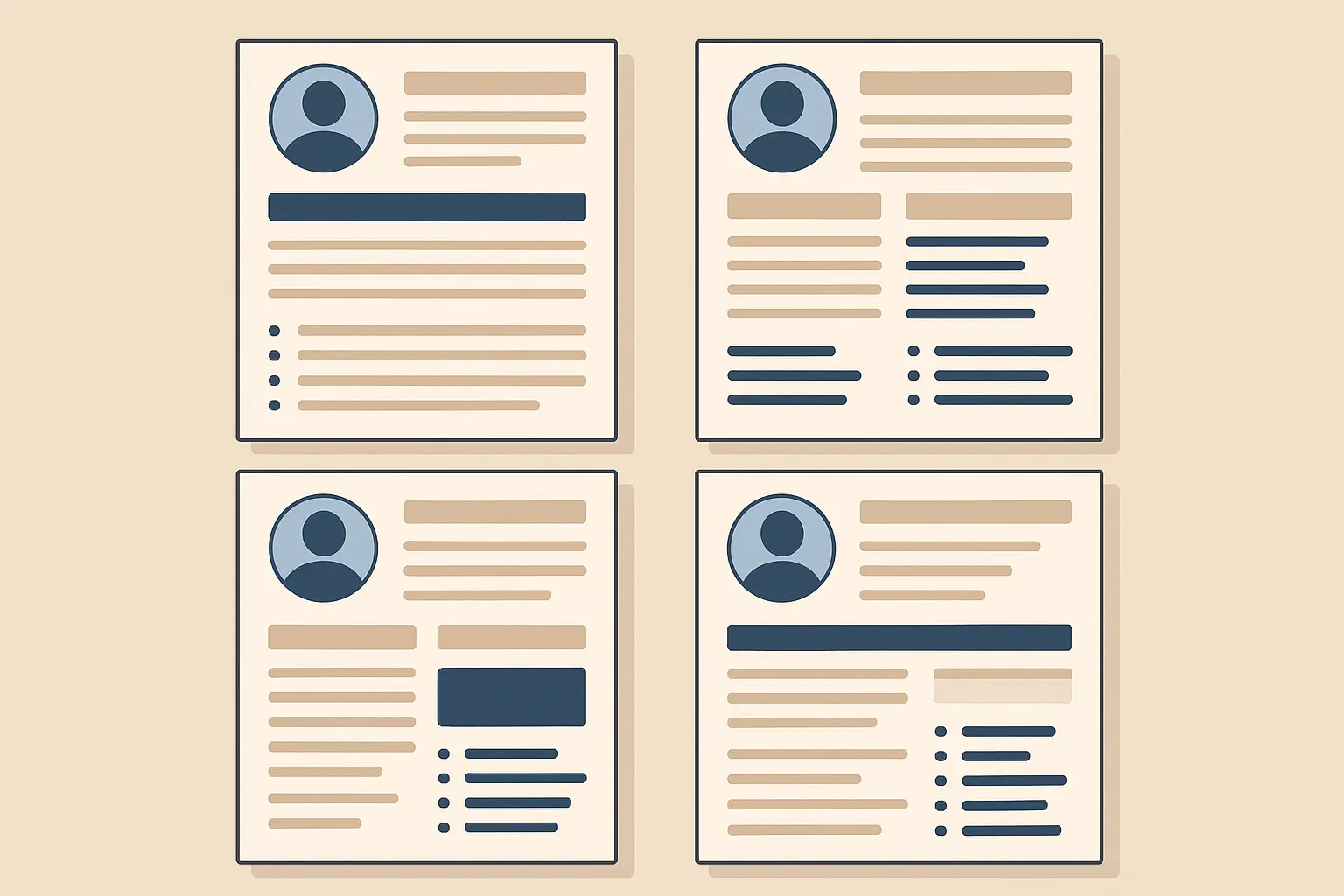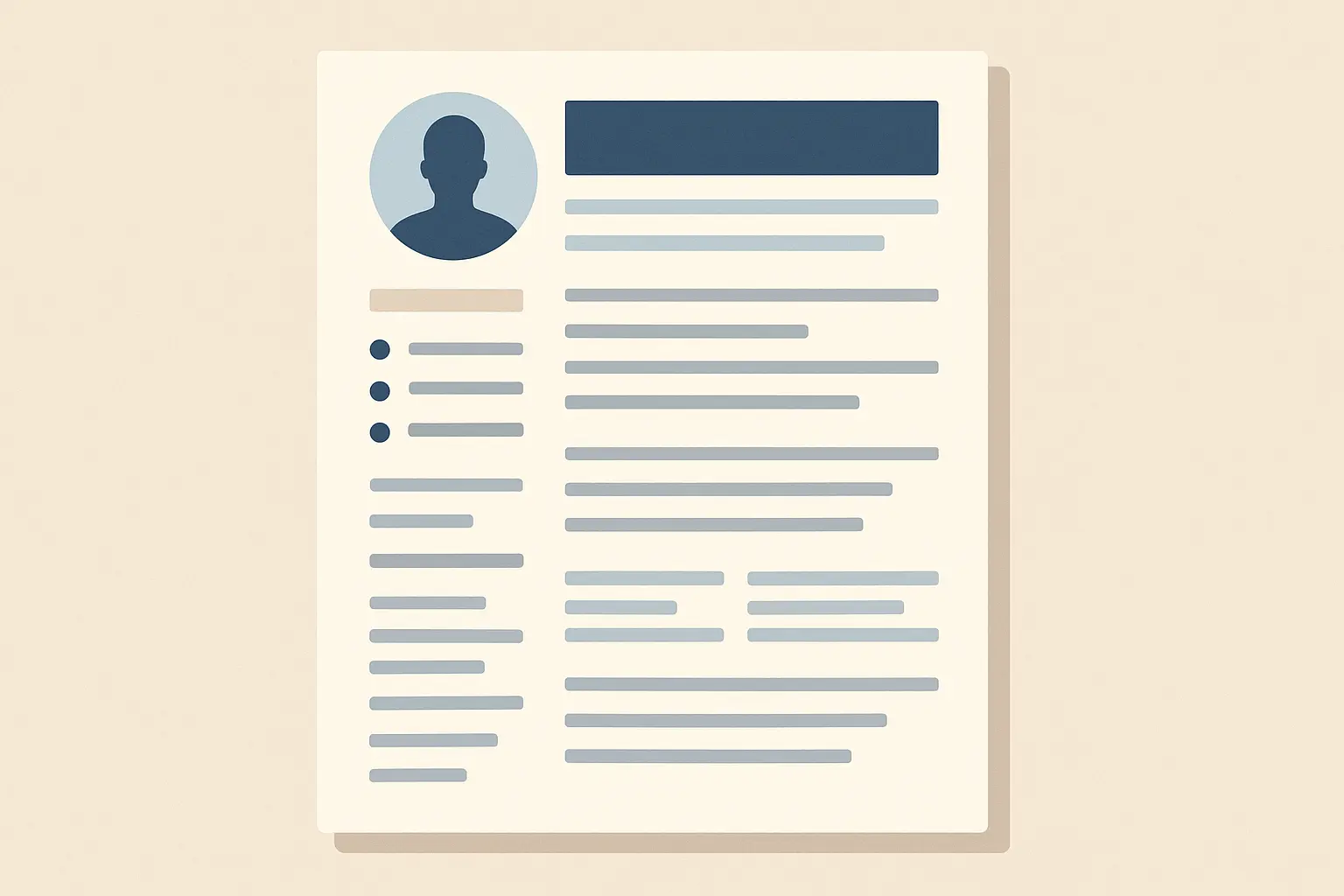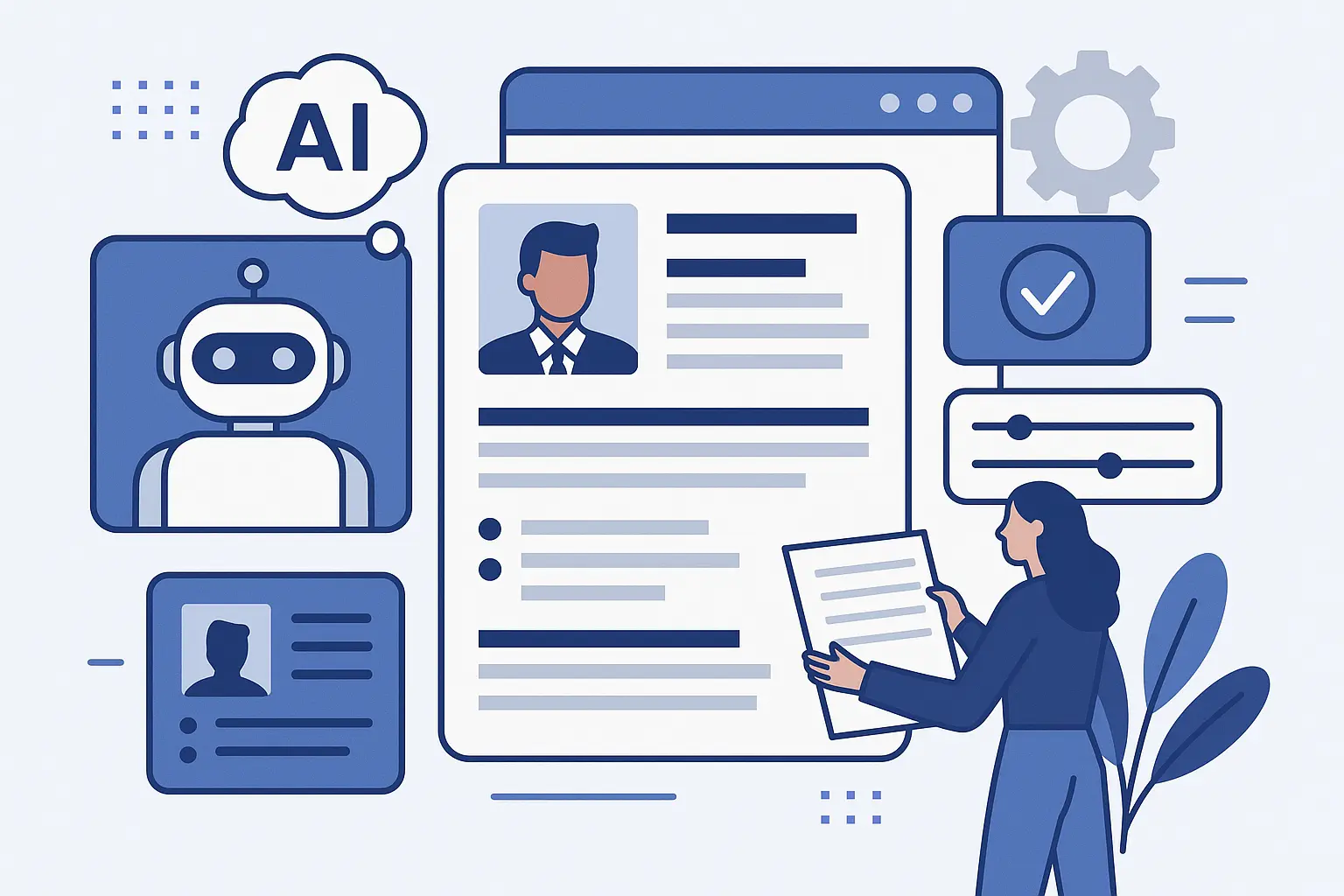How Far Back Should Your Resume Go? (Spoiler: It’s Not Always 10 Years)

Here’s the thing nobody tells you about resume timelines: that “10-15 year rule” everyone talks about? It’s more like a suggestion than gospel.
I used to stress about this constantly. Should I include that marketing job from 2008? What about my first role out of college that taught me everything about customer service? After helping hundreds of people with their resumes (and making plenty of mistakes with my own), I’ve learned the real answer is way more interesting than “just stick to 10 years.” That’s why one of the most common questions people ask is “how far back should a resume go”, and the answer isn’t always as simple as it seems.
According to Resume Builder research, the key is to “identify the number of years your target role calls for, as specified in most job ads, and go back at least that far,” making your timeline decision based on actual job requirements rather than generic advice.
The truth is, it depends on your situation. Let me show you exactly how to figure out what works for YOU.
Table of Contents
- The 10-Year Rule: When It Works (And When It Doesn’t)
- Your Industry Changes Everything
- Career Stage Makes All the Difference
- Smart Steps to Find Your Perfect Timeline
- Age Discrimination: Let’s Talk About the Elephant in the Room
- Formatting Tricks That Actually Work
- How Resume Builder IQ Takes the Guesswork Out
TL;DR
- Most resumes work best with 10 years of experience, but your industry and career stage can change everything
- Tech and digital fields need stricter limits while healthcare and education can go longer
- Senior executives often benefit from showing 15-20 years to demonstrate leadership progression
- New grads should include everything relevant, including internships and part-time work
- Smart formatting lets you include older experience without overwhelming readers
- Age discrimination is real, but strategic choices can help protect your candidacy
- Testing different versions helps you find what actually gets results
The 10-Year Rule: When It Works (And When It Doesn’t)
The 10-year guideline isn’t some arbitrary number career experts made up over coffee. It actually makes sense for most people because that’s about how long it takes for skills and workplace practices to start feeling outdated.
But here’s where it gets interesting—I’ve seen plenty of situations where breaking this rule actually helped people land better jobs.
When I was switching from traditional marketing to digital, I almost left off my early experience managing trade show booths. Turns out, that hands-on customer interaction experience was exactly what made me stand out for a customer success role. Sometimes the “irrelevant” stuff is actually your secret weapon.
Why 10 Years Usually Hits the Sweet Spot
The 10-year timeframe works for most people because it captures your current skills without making you look outdated. Technology and workplace practices change fast—what seemed cutting-edge in 2012 might make you look behind the times now.
Plus, applicant tracking systems love recent experience. When considering how far back your resume should go, it’s crucial to understand that ATS resume format requirements play a significant role in determining how far back a resume should go for your work history presentation.
The Relevance Reality Check
Here’s something I learned the hard way: including my experience with an outdated CRM system actually hurt my candidacy. Instead of showing I was experienced, it made hiring managers think I was stuck in the past.
Experience from more than 10 years ago often feels irrelevant to hiring managers, especially in fast-moving industries. If you’re not careful, older experience can work against you instead of helping you.
ATS Systems Play Favorites with Recent Stuff
Those applicant tracking systems that scan your resume before humans ever see it? They’re programmed to prioritize recent work experience when looking for relevant keywords. Stick to 10 years of detailed history, and you’re more likely to make it past the robots to actual people.
When Breaking the Rule Makes Perfect Sense
Sometimes the 10-year rule is just wrong for your situation. Here’s when you should ignore conventional wisdom:
Senior Executives Need the Full Leadership Story
If you’re going for C-suite roles, you often need 15-20 years to show that progression from manager to director to VP to executive. Younger professionals simply can’t demonstrate that kind of sustained leadership trajectory.
When you’re competing for executive roles, hiring committees want to see the full arc of your career development, not just the highlights reel. This is one of the rare cases where the answer to how far back should a resume go extends beyond the typical 10 years.
Some Skills Never Go Out of Style
Military experience, security clearances, specialized certifications, or expertise with systems that are still widely used—these might be worth including even if they’re older than 10 years. They represent unique qualifications that set you apart from everyone else.
Career Changers Need Context
When you’re switching industries, older experience might provide crucial context for your diverse skill set. A marketing professional transitioning to tech sales might benefit from including that 12-year-old consulting experience because it shows relationship-building skills that directly translate to enterprise sales.
Your Industry Changes Everything
Here’s what I wish someone had told me earlier: different industries have completely different expectations. What works in tech will absolutely bomb in healthcare, and vice versa.
I’ve worked across multiple industries, and the differences are honestly pretty dramatic. Let me break it down for you:
| Industry | Recommended Timeline | Key Considerations |
|---|---|---|
| Technology/Software | 8-10 years | Skills become obsolete quickly |
| Healthcare/Medical | 12-15 years | Clinical expertise builds over time |
| Finance/Banking | 10-12 years | Regulatory knowledge accumulates |
| Education/Academia | 15+ years | Career progression is slower |
| Manufacturing | 12-15 years | Process knowledge valuable |
| Consulting | 10-12 years | Client diversity matters |
If you’re unsure how far back should a resume go for your specific field, this chart gives you a strong starting point.
Fast-Moving Fields: Keep It Current or Get Left Behind
Tech, Digital Marketing, Startups: Stick to 8-10 years max. That JavaScript framework you mastered in 2010? It’s probably making you look outdated now.
Modern professionals are increasingly turning to AI tools for resume optimization. As “Using AI to Craft the Perfect Resume” from Dice notes, “A.I. tools such as ChatGPT can be a big help in writing and improving your resume. But the key is to realize the shortcomings of A.I.: these tools are not humans, and they base their understanding of language on what they’ve read.”
Software Development’s Rapid Evolution Problem
I once reviewed a resume that listed extensive COBOL experience from 15 years ago as a primary skill. While COBOL still has niche applications, leading with it made the candidate seem completely out of touch with modern development practices.
Programming experience older than 10 years often includes obsolete languages or outdated frameworks that could actually hurt your candidacy rather than help it.
Digital Marketing’s Platform Revolution
The marketing tactics, social media platforms, and analytics tools that dominated the field a decade ago? They bear almost no resemblance to today’s digital landscape. If you’re still talking about your MySpace marketing campaigns, it’s time to let that go.
Relationship-Based Fields: Experience Gets Better with Time
Healthcare, Education, Finance: You can often go 12-15 years because experience actually gets better with time. A nurse with 20 years of experience isn’t outdated—they’re seasoned.
Medical Professionals Build Expertise Over Decades
Physicians, nurses, and other healthcare professionals often benefit from showing 15+ years of experience because clinical expertise and patient care skills accumulate meaningfully over time. The fundamental principles of healthcare remain more consistent than in technology fields.
Traditional Industries Still Value the Long Game
Manufacturing, finance, and government roles often expect longer work histories that show stability and deep industry knowledge. These sectors value institutional knowledge and long-term relationship building.
For professionals in banking and finance, understanding banking interview questions can help you determine which aspects of your extended work history to emphasize when preparing for industry-specific discussions.
Career Stage Makes All the Difference
Where you are in your professional journey completely changes the game. The approach that worked for me as a new graduate would be absolutely terrible for my resume now, and vice versa.
New Grads and Early Career: Every Experience Counts
When you’re just starting out, include everything relevant—internships, part-time positions, significant volunteer work, even that summer job that taught you customer service skills.
Don’t Be Embarrassed by “Small” Jobs
I remember feeling embarrassed about including my college job at a coffee shop on my first resume. Turns out, that customer service experience was exactly what helped me land my first marketing role because it showed I could handle difficult situations with grace.
Every position that shows initiative, skill development, or industry exposure becomes valuable when you have limited professional experience.
Academic Projects Bridge the Gap
A recent computer science graduate might include their senior capstone project where they built a mobile app, their summer internship at a startup, and their part-time work as a coding tutor. None individually represents extensive experience, but together they demonstrate technical skills, real-world application, and teaching ability.
Mid-Career Professionals: The Sweet Spot Strategy
If you’ve got 5-15 years of experience, you’re in the perfect position to use that traditional 10-year guideline. You have enough experience to be selective while still needing to show your complete professional development story.
Quality Beats Quantity Every Time
Choose positions that best demonstrate your career trajectory and key achievements rather than including every job you’ve held. Strategic selection creates a stronger narrative than a comprehensive but diluted work history.
Senior Professionals: Strategic Timeline Management
According to Resume Builder’s research, “a senior- or director-level candidate needs to show extensive experience in the industry, but it’s still best not to provide more than 15 years of work history or have a resume longer than two pages.”
The challenge becomes showing the breadth of your experience without creating a document that nobody wants to read.
Executive Summary Approach
Senior professionals can reference longer career spans in their executive summary while limiting detailed job descriptions to the most recent 10-15 years. This acknowledges your extensive experience while keeping the detailed content focused.
Strategic Name-Dropping
Brief mentions of significant earlier roles (company names and titles only) can provide valuable context without cluttering the resume. This lets you show career progression and impressive affiliations without dedicating precious space to old job descriptions.
Smart Steps to Find Your Perfect Timeline
Okay, let’s get practical. I’m going to walk you through exactly how to figure out your ideal timeline without all the guesswork.
Step 1: Stalk Your Target Jobs (In a Professional Way)
Pull up 5-10 job postings for roles you actually want. Look for phrases like “5+ years experience” or “seasoned professional with 10+ years.” That’s your baseline right there.
Understanding what employers prioritize helps you make informed decisions about which experiences to highlight and which to minimize or exclude.
Step 2: Be Brutally Honest About Relevance
Ask yourself: Does my job from 2012 actually help me get the job I want in 2024? That’s really the core of the question, how far back should a resume go, and the answer depends on relevance more than dates.
This step requires brutal honesty about what’s actually helping versus what’s just taking up space. I had to cut some positions I was personally proud of because they weren’t serving my current goals.
Step 3: Research Your Industry’s Unwritten Rules
Every field has its own expectations and norms. Network with professionals in your target industry, check out career resources specific to your field, and pay attention to what successful people in your space are doing.
Step 4: Test Different Versions Like a Scientist
This is where it gets interesting. Create two versions of your resume—one with 8 years of experience, one with 12. Send them out and track which one gets more responses. Data doesn’t lie.
I did this experiment myself and was shocked when the shorter version performed better. Sometimes we’re too attached to our own history.
| Resume Version | Timeline Length | Response Rate | Interview Rate | Notes |
|---|---|---|---|---|
| Version A | 8 years | Track % | Track % | Conservative approach |
| Version B | 12 years | Track % | Track % | Extended experience |
| Version C | 10 years + summary | Track % | Track % | Hybrid approach |
Age Discrimination: Let’s Talk About the Elephant in the Room
Nobody wants to discuss this, but if you’re over 50, you’re probably worried about it. Here’s what actually helps:
The reality is that age discrimination exists, even though it’s illegal for workers over 40. Smart resume strategy can help counter assumptions while still showcasing your extensive experience.
Protecting Yourself While Showcasing Experience
Remove graduation dates from anything older than 15 years. Your 1987 MBA doesn’t need a date—the degree still counts. I’ve seen this make a real difference for clients. One executive removed his 1985 MBA graduation date and immediately started getting more callbacks.
Lead with recent tech skills. Nothing says “I’m current” like mentioning you just completed a certification in the latest industry software. Emphasize recent training and digital competence to counter stereotypes about older workers and technology.
Focus on results, not years. Instead of “20 years of management experience,” try “Led teams that increased revenue by 40%.”
Legal Protections and Practical Reality
The law protects you, but hiring bias can be subtle and difficult to prove. Focus on what you can control through smart resume strategy rather than what you can’t control about people’s assumptions.
Formatting Tricks That Actually Work
When you’ve got a long career, here’s how to fit it all without creating a novel that nobody will read:
Understanding the fundamentals of professional resume format becomes even more critical when managing extensive work histories.
The “Detailed vs. Summary” Approach
Last 10 years: Full bullet points with achievements and specific metrics
Older stuff: Just “Senior Analyst, ABC Company (2008-2012)”
This hybrid strategy gives readers the detailed information they need about your current capabilities while acknowledging your broader career progression.
A marketing director might provide full details for their last two positions (2019-2024) including specific campaign results and team leadership metrics, while listing earlier roles from 2010-2019 with just titles, companies, and dates.
Early Career Consolidation
Had three similar entry-level jobs? Combine them: “Marketing Associate Roles, Various Companies (2005-2010).” This streamlines your presentation while still acknowledging the breadth of your early professional development.
Skills-First Strategy
Lead with what you can do, then support it with where you did it. This works especially well for career changers who need to emphasize transferable skills over chronological progression.
For professionals seeking comprehensive guidance on structure, exploring various resume format secrets can provide additional strategies for managing extensive work histories effectively.
How Resume Builder IQ Takes the Guesswork Out
Look, I get it—this is a lot to figure out on your own. That’s why tools like Resume Builder IQ exist. Their AI actually analyzes your specific industry and career level to recommend the optimal timeline.
Resume Builder IQ’s platform eliminates the confusion around optimal work history length by providing intelligent, personalized recommendations based on your unique situation. Whether you’re wondering about including internships or presenting decades of executive experience, the advanced algorithms suggest the best timeline approach for your target roles.
Plus, you can easily test different versions without starting from scratch each time. With 25+ ATS-optim ized templates and real-time customization features, you can easily test different timeline approaches and see which version performs best for your target roles. The platform’s expert guidance ensures your resume timeline maximizes interview potential while maintaining professional formatting standards that stand out in today’s competitive job market.
When evaluating your options, consider reading about the best resume builders to understand how Resume Builder IQ’s intelligent timeline recommendations compare to other platforms in the market.
Ready to create a resume that showcases your experience strategically? Try Resume Builder IQ’s intelligent platform and let our AI-powered suggestions guide you to the perfect work history length for your career goals.
The Bottom Line
Here’s what I want you to remember: Your resume isn’t your autobiography. It’s a marketing document designed to get you interviews.
The “perfect” timeline is the one that gets you callbacks. Sometimes that’s 8 years, sometimes it’s 15. Sometimes it’s everything you’ve ever done if you’re just starting out.
Stop overthinking the rules and start thinking about results. The 10-year guideline works for many professionals, but your industry, career stage, and specific goals should ultimately drive your decision. Focus on including experience that directly supports your current objectives while considering how hiring managers and ATS systems will process your information.
Whether you’re a recent graduate including every relevant experience or a senior executive strategically presenting decades of leadership, the key is intentional curation rather than arbitrary inclusion. If you’ve been wondering how far back should a resume go, remember that the best choice is the one that gets you more interviews, not the one that follows rigid rules. Take time to research your industry’s expectations, analyze target job requirements, and test different approaches to find what generates the best response.
Your perfect timeline might be different from conventional wisdom, and that’s perfectly fine as long as it serves your career goals effectively.
And hey, if you’re still stressed about this decision, you’re not alone. I’ve been there, and so has everyone else trying to figure out this whole career thing. The key is making an informed choice and moving forward with confidence.
For specialized roles requiring unique formatting considerations, such as government positions, exploring resources such as federal resume template guidance can provide additional insights into industry-specific timeline expectations.
Ready to build a resume that actually works for your situation? Stop second-guessing yourself and start testing what gets results.








